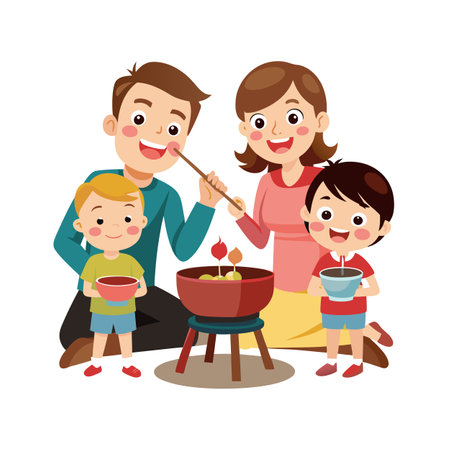1. Understanding the Unique Dynamics of a Blended Family
Blended families bring together different backgrounds, traditions, and expectations, which can make the holiday season both exciting and challenging. Each family member may have their own cherished traditions, and finding a way to honor them while creating new ones requires patience, communication, and flexibility.
The Challenges of Merging Holiday Traditions
When two families come together, they often bring different ways of celebrating holidays. Some members might have strong emotional ties to certain traditions, while others may feel uncertain about how to fit in. Here are some common challenges blended families face:
| Challenge | Description |
|---|---|
| Differing Family Expectations | Each side of the family may have long-standing traditions that they want to continue. |
| Scheduling Conflicts | Coordinating time between multiple households can be complicated. |
| Emotional Attachments | Children and adults alike may struggle with changes to familiar traditions. |
| Cultural or Religious Differences | If families come from different cultural or religious backgrounds, blending customs can require extra effort. |
The Opportunities That Come with Blending Traditions
While merging traditions can be challenging, it also presents opportunities for growth and connection. By approaching the holiday season with an open mind, blended families can create meaningful experiences that reflect their unique bond. Here are some benefits:
- A Chance to Create New Traditions: Instead of choosing one tradition over another, blended families can establish new customs that incorporate elements from both sides.
- A Stronger Sense of Togetherness: Working together to plan celebrations fosters unity and helps everyone feel included.
- A More Inclusive Holiday Experience: Blending traditions allows family members to learn about each other’s backgrounds and appreciate different perspectives.
The Importance of Flexibility
The key to navigating holiday traditions in a blended family is flexibility. Being open to compromise ensures that everyone feels heard and valued. Some practical ways to stay flexible include:
- Create a Holiday Plan Together: Sit down as a family and discuss which traditions matter most to each person.
- Avoid Overloading the Schedule: Trying to do everything can lead to stress—prioritize meaningful moments over perfection.
- Acknowledge Emotions: Change can be difficult; allow space for conversations about feelings and adjustments.
- Celebrate on Different Days: If necessary, celebrate certain traditions on alternate days to accommodate everyone’s needs.
Merging holiday traditions in a blended family takes time, but with understanding and flexibility, it can lead to a richer, more meaningful holiday experience for all.
2. Communicating Openly and Setting Expectations
One of the most important aspects of navigating holiday traditions in a blended family is clear and open communication. When multiple families come together, ensuring that everyone is on the same page can help create a smoother and more enjoyable holiday experience for all.
Why Communication Matters
The holiday season can bring joy, but it can also bring stress—especially when different families have different traditions, schedules, and expectations. Without clear communication, misunderstandings can arise, leading to unnecessary tension. To prevent this, its essential to have honest conversations with your partner, ex-partners, and children about what to expect.
Who Should Be Involved in Holiday Planning?
| Person | Role in Holiday Planning |
|---|---|
| Your Partner | Work together to create a plan that respects both of your family traditions. |
| Ex-Partners | Coordinate schedules to ensure children can enjoy time with both sides of their family. |
| Children | Listen to their preferences and concerns so they feel included in the decision-making process. |
| Extended Family | Set boundaries and communicate plans early to manage expectations. |
Tips for Effective Communication
- Start Early: Discuss holiday plans well in advance to avoid last-minute stress.
- Be Flexible: Understand that compromises may be necessary to accommodate everyones needs.
- Use a Shared Calendar: Keep track of schedules using a digital calendar to avoid conflicts.
- Avoid Assumptions: Clearly express your expectations instead of assuming others will know them.
- Create New Traditions: If blending traditions is challenging, consider creating new ones that everyone can enjoy together.
Navigating Conversations with Ex-Partners
If you share custody of children with an ex-partner, maintaining open and respectful communication is key. Focus on what’s best for the kids rather than personal differences. Keep discussions centered on logistics, ensuring that children get quality time with both sides of the family while minimizing disruptions to their routine.
The Importance of Listening to Your Children
The holidays should be a joyful time for kids. Ask them how they feel about the holiday plans and take their opinions into consideration. This helps them feel valued and involved rather than simply being told where they need to be at certain times.
By prioritizing open communication and setting clear expectations, blended families can reduce stress and enjoy a holiday season filled with love, laughter, and meaningful connections.

3. Respecting and Honoring Everyones Traditions
Blending holiday traditions in a mixed family can be a beautiful way to celebrate diversity while creating new shared experiences. Finding ways to respect and honor each persons background helps everyone feel valued and included.
Finding Common Ground
Each family member may have different traditions, but instead of choosing one over the other, try blending them together. This could mean incorporating elements from multiple celebrations into one event or alternating traditions each year.
Creating New Traditions Together
While honoring existing customs is important, creating new traditions unique to your blended family can help strengthen bonds. Consider activities that everyone can enjoy together, such as:
| Traditional Activity | New Blended Tradition Idea |
|---|---|
| Baking cookies with grandma’s recipe | Baking cookies with a mix of favorite family recipes |
| Opening gifts on Christmas Eve | Exchanging one small gift on Christmas Eve and the rest on Christmas morning |
| Cultural holiday meal from one side of the family | A potluck-style dinner featuring dishes from both sides of the family |
Encouraging Open Communication
The key to successfully blending traditions is open communication. Talk with each family member about what traditions matter most to them and find creative ways to include those elements in your celebrations.
Acknowledging Everyone’s Feelings
Change can be difficult, especially when it involves cherished traditions. Be patient and empathetic with family members who may feel nostalgic or resistant to change. Remind everyone that blending traditions isn’t about replacing old ones but about making space for new memories together.
The Importance of Flexibility
No two families are the same, so flexibility is essential. Some years, you may follow certain traditions more closely than others, and that’s okay. The goal is to create a holiday season where everyone feels respected, loved, and included.
4. Managing Logistics and Scheduling with Multiple Households
Coordinating holiday plans in a blended family can feel overwhelming, especially when multiple households are involved. Finding a balance that works for everyone while minimizing stress takes careful planning and open communication. Here are some practical tips to help manage schedules and create a smoother holiday experience for all.
Communicate Early and Clearly
Start discussing holiday plans well in advance to avoid last-minute conflicts. Consider setting up a shared calendar or group chat where everyone can stay informed about travel dates, family gatherings, and special traditions.
Create a Fair and Flexible Schedule
Work together to establish a schedule that allows children to spend quality time with each side of the family. Flexibility is key—sometimes celebrating on different days or alternating years can help accommodate everyones needs.
Example of Holiday Scheduling Options
| Year | Parent As Household | Parent Bs Household |
|---|---|---|
| Even Years | Thanksgiving | Christmas |
| Odd Years | Christmas | Thanksgiving |
Avoid Overcommitting
The holidays can be hectic, so try not to pack too many activities into a short period. Prioritize the most meaningful traditions and allow downtime for relaxation and connection.
Consider Virtual Celebrations When Needed
If travel or scheduling conflicts make it difficult to be together in person, plan virtual celebrations. A video call during gift opening or sharing a holiday meal online can help maintain connections even from afar.
Prepare Kids for Transitions
If children will be moving between households during the holidays, talk to them ahead of time about what to expect. Help them pack their favorite items, remind them of the fun traditions they’ll enjoy, and reassure them that both sides of their family love them.
Be Willing to Compromise
No plan will be perfect for everyone, so be open to adjusting expectations. The goal is to create positive holiday experiences rather than focusing strictly on fairness or tradition.
Keep the Focus on Family Joy
The holidays are about spending time with loved ones and making memories. By staying organized, flexible, and communicative, you can reduce stress and ensure that everyone enjoys the season—no matter how complex the logistics may be.
5. Focusing on the Meaning of the Holidays
When blending family traditions, its easy to get caught up in logistics—whos celebrating where, which traditions to follow, and how to make everything fair. But at the heart of the holidays is something much more important: connection and love. Instead of stressing over the details, focus on creating meaningful experiences that bring everyone together.
Prioritizing Togetherness Over Perfection
Holidays don’t have to be picture-perfect to be special. What truly matters is spending quality time with loved ones and making lasting memories. Here are some ways to shift the focus from logistics to connection:
| What Can Cause Stress | How to Refocus on Connection |
|---|---|
| Deciding whose traditions to follow | Create new traditions that blend elements from both families |
| Coordinating multiple schedules | Plan flexible celebrations that prioritize time together over specific dates |
| Making everything “fair” | Focus on shared experiences rather than dividing everything evenly |
| Expecting everything to go perfectly | Embrace imperfections and enjoy the moment as it happens |
Creating Meaningful Holiday Moments
The best holiday memories often come from simple moments rather than grand gestures. Here are a few ideas for fostering connection:
- Storytelling Night: Have each family member share a favorite holiday memory or tradition from their past.
- Cooking Together: Prepare a meal or bake treats as a family, incorporating recipes from different backgrounds.
- Giving Back: Volunteer or donate as a family to spread holiday cheer beyond your home.
- Themed Movie Night: Pick classic holiday movies and watch them together with snacks and cozy blankets.
- Craft or DIY Gift Exchange: Make homemade gifts or decorations that reflect each family member’s unique personality.
The True Spirit of the Holidays
No matter where or how you celebrate, what makes the holidays special is the love shared between family members. Blended families may have unique challenges, but they also have the opportunity to create something truly special—new traditions built on love, respect, and togetherness. By focusing on connection rather than perfection, every holiday season can become a cherished memory for years to come.


